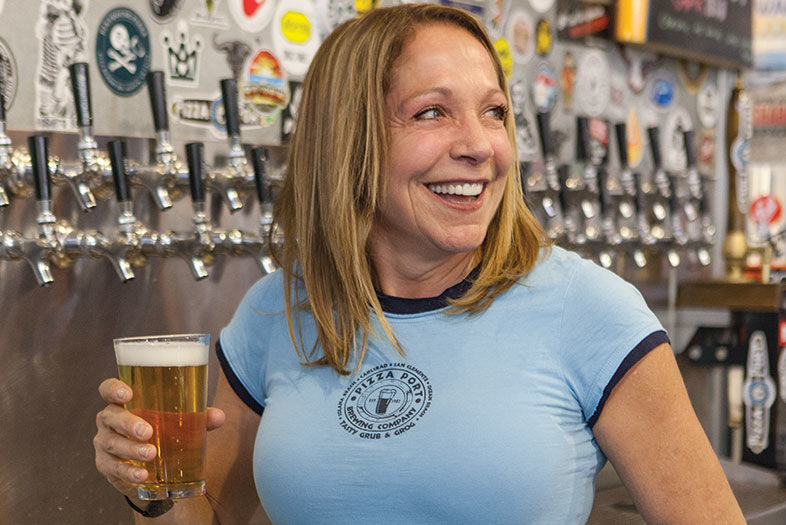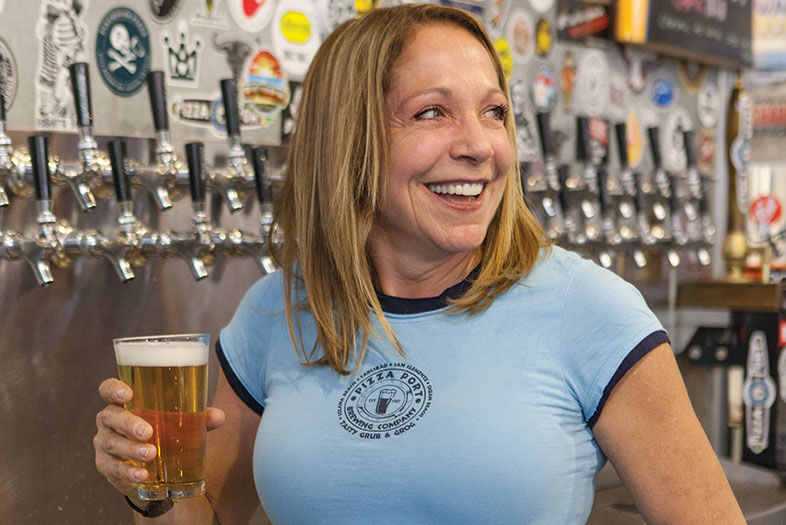Pizza Port has played an integral role in developing the modern “San Diego style” of craft beer and has nurtured some of San Diego’s most famous brewers. They were brewing IPAs in Solana Beach before Stone, Ballast Point, or Coronado Brewing Company came along. But despite its status as the city’s most-medaled brewery by far, the humble pizza joint tends to keep a relatively low profile. Pizza Port co-founder Gina Marsaglia looks back on the craft beer scene’s earliest days.
You recently celebrated Pizza Port’s 30th anniversary with a special beer. Was it a walk down memory lane?
Yeah, one of the best parts of doing our “reunion beer”—the 30th anniversary release of our original recipe, Pipes Pale Ale—was getting all those original guys together. It was most of the people who have brewed at Solana in the last ten years or so. Then my brother, Vince, and our current brewer, Josh Schaner, brewed the original recipe of our first IPA, Swami’s, and was true to style for what was popular back then. It was a little more malty and a little bit darker in color.
So this was before the whole “super hoppy, San Diego-style” IPA was born?
Yes. Swami’s is still my “go-to” beer, even after all these years. It’s the one that means the most to us.
When Pizza Port opened in 1987, you weren’t brewing beer. Karl Strauss opened in 1989, and you went to work there briefly for fun. Was being at Karl Strauss the first eye-opening experience of what craft beer was like?
It really was. Craft beer just wasn’t around. The first craft beer I had was a Sam Adams, and I remember thinking, “This is the best beer I’ve ever had.” So that was a life-changing experience for me.
Did it inspire you to start brewing?
Vince and I had been practicing and brewing beer as a hobby in Solana—we turned the back area into a little makeshift brewery and we were brewing beer and meads and experimentals. After the makeshift system—which used plastic lemonade containers that we got from Hot Dog on a Stick—we met Paul and Rob Soltys, who went on to open Premier Stainless. They put in our first system, which was a seven-barrel brewhouse with one 10-barrel fermenter.
What was the first beer you made?
That was Shark Bite, a recipe from Vince and Paul. We started with five core beers and then expanded to eleven, the maximum we had room for.
What was the prevailing beer style in those days? Did you make them less aggressive so they’d be more palatable?
Not really. Today’s Shark Bite recipe is pretty close to the original, so there were a lot of aggressive beers, but then we also brewed the mellow ones, too. Looking back, it’s funny that all our beers were the same price. You could get a 12-percent barleywine for the same price as the lightest beer we made!
Adding craft beer to the pizza place turned out to be a good idea.
It was. But we were just having fun. We weren’t even really thinking about it as a business. And with a seven-barrel system, you move through the beer so fast that, if it’s on tap today, it may not be the next time you come in.
The beer scene was basically you, Karl Strauss, and Callahan’s, which evolved into San Diego Brewing Company. Was that it?
There were a few coming and going. There was also Hops at UTC and Red Kettle in Encinitas. You needed a loyal following in those days, and you had to do a lot of beer education. It was hard to get people to love it. We had Bud Light and Coors Light on tap for a long time during those early years. You were around to witness the beginning of many other iconic San Diego breweries, like Stone. I remember I was at the Craft Brewers Conference in Austin a couple of years before Stone opened. I was wearing a Shark Bite Red Ale shirt and I heard [Stone co-founder] Greg Koch remark on it. He said he came into Solana Beach all the time and that he was thinking of opening a brewery. I know Greg and Steve Wagner did a bunch of their business planning at the Solana Beach location.
What do you remember of your first brewing-experienced hire, Tomme Arthur?
He was not afraid to try anything! Of course, it was different back then, when there was no competition and nobody else was doing the barrel-aged and Belgian-inspired beers he was experimenting with.
Were those beers a tougher sell to the public?
They were in such little quantities that we didn’t care if anybody bought them! In fact, we thought, “Please don’t buy it. Then we can drink it!” We had a hard time parting with some of those.
Pizza Port is not a franchise—all five locations have a distinct identity, and that’s because you’ve allowed each brewer to maintain their unique style and approach.
Yeah, that kind of happened organically. I didn’t want to take away from the creativity at each brewpub. When we opened Bressi, I wanted that location to brew the core beers for all the pubs, so they’re all consistent, and then we could have the brewers at each location be more creative and do the beer sharing. I know that’s not what a lot of people do, but it works for us.
Are there still things you want to do, or locations you want to open?
Definitely, but the last thing I want to do is open a location near another brewery—and that’s getting harder and harder to find. It also seems like, no matter where we look, there’s a pizza place right next door. You don’t make very many friends if you go into a community as a direct competitor. Luckily, this industry is the friendliest I’ve found. Hardly anybody thinks of someone else as a competitor, unless you completely copy what they’re doing.

PARTNER CONTENT
Meet One of San Diego’s Original Beer Pioneers












